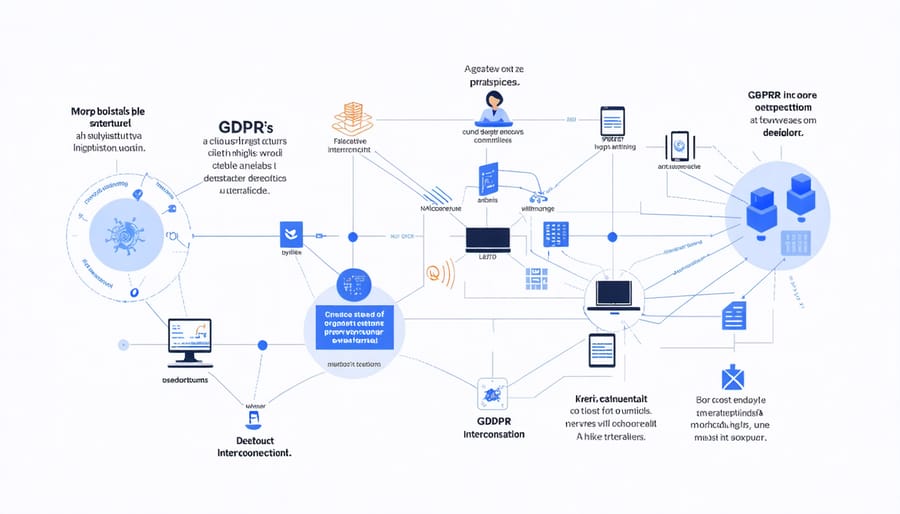As artificial intelligence reshapes our digital landscape, the intersection of AI systems and GDPR compliance presents unprecedented challenges for organizations worldwide. Ensuring GDPR compliance in AI development requires a delicate balance between innovation and privacy protection, making it crucial for developers and business leaders to understand this complex relationship.
The explosive growth of AI applications—from automated decision-making systems to machine learning algorithms—has intensified scrutiny over data protection practices. With GDPR’s strict requirements for transparency, data minimization, and user consent, organizations must carefully navigate how they collect, process, and store personal data within their AI frameworks.
This convergence of regulatory compliance and technological advancement represents more than just a legal obligation; it’s an opportunity to build trust with users while driving responsible AI innovation. As businesses increasingly rely on AI-powered solutions, understanding how to implement privacy-by-design principles and maintain GDPR compliance has become fundamental to sustainable digital transformation.
By addressing these challenges head-on, organizations can create AI systems that not only comply with GDPR requirements but also set new standards for ethical data handling and algorithmic transparency in the digital age.

GDPR’s Core Principles in AI Development
Data Minimization and Purpose Limitation
Data minimization and purpose limitation are two fundamental GDPR principles that significantly impact how AI systems are developed and deployed. These principles require organizations to collect and process only the data that’s absolutely necessary for specific, declared purposes.
For AI systems, this means carefully evaluating what data is truly needed for training models and ensuring that the collection scope doesn’t exceed these requirements. For example, if an AI system is designed to analyze customer purchase patterns, it shouldn’t collect personal information like political views or health data that’s irrelevant to this purpose.
Organizations must clearly define and document their AI system’s purposes before data collection begins. This includes specifying how the data will be used in training, testing, and deployment phases. When collecting data for multiple purposes, each purpose must be explicitly stated and justified.
These principles also affect how long data can be retained. Once an AI model is trained and validated, organizations need to assess whether keeping the training data is necessary. If not, it should be deleted or anonymized to comply with GDPR requirements.
Practical implementation might include:
– Regular data audits to ensure only necessary information is collected
– Implementation of data sunset policies
– Clear documentation of data usage purposes
– Technical measures to automatically filter out unnecessary data
– Regular reviews of AI model requirements and data needs
This approach not only ensures GDPR compliance but also leads to more efficient and focused AI systems.
Transparency and Explainability Requirements
Under GDPR, organizations using AI systems must ensure their decision-making processes are transparent and explainable to data subjects. This means individuals have the right to understand how AI algorithms process their personal data and make decisions that affect them.
When AI systems make automated decisions, organizations must provide clear information about:
– The logic involved in the decision-making process
– The significance and potential consequences of such processing
– How the AI system reached its conclusions
For example, if an AI system is used in loan approval processes, banks must explain to customers how their personal data influenced the decision, what factors were considered, and why a particular outcome was reached.
To meet these requirements, organizations should:
1. Document their AI systems’ decision-making processes
2. Use interpretable AI models when possible
3. Maintain clear audit trails of automated decisions
4. Provide meaningful information in plain language
5. Implement mechanisms for human review
Organizations must also ensure their AI systems don’t make significant decisions about individuals without human oversight. When automated decision-making is used, individuals have the right to:
– Obtain human intervention
– Express their point of view
– Contest the decision
These transparency requirements pose particular challenges for complex AI systems, especially those using deep learning or neural networks. Organizations must balance the need for sophisticated AI capabilities with their obligation to provide clear, understandable explanations to data subjects.
Practical Compliance Strategies for AI Systems
Privacy by Design in AI Development
Privacy by Design (PbD) is a proactive approach that integrates privacy protection into AI systems from the initial development stages rather than treating it as an afterthought. When developing AI solutions, meeting privacy and security requirements becomes significantly easier when privacy considerations are embedded from day one.
To implement PbD in AI development, start by conducting thorough data protection impact assessments (DPIAs) before beginning any new project. This helps identify potential privacy risks and necessary safeguards early in the development cycle. Consider implementing techniques like data minimization, ensuring you collect only the data necessary for your AI system’s intended purpose.
Practical steps include:
– Using privacy-preserving techniques such as differential privacy and federated learning
– Implementing robust data encryption and access controls
– Creating clear documentation of data processing activities
– Building user-friendly privacy controls and transparency features
– Regular testing and validation of privacy measures
Remember to maintain privacy throughout the entire AI lifecycle, from data collection and training to deployment and maintenance. This includes establishing clear data retention policies and ensuring proper data disposal methods are in place.
By embracing Privacy by Design principles, organizations can build trust with users while maintaining compliance with GDPR regulations, creating a win-win situation for both developers and end-users.

Data Protection Impact Assessments
Under GDPR, organizations implementing AI systems must conduct Data Protection Impact Assessments (DPIAs) when processing activities are likely to result in high risks to individuals’ rights and freedoms. This is particularly crucial for AI systems that handle sensitive personal data or make automated decisions affecting people’s lives.
A DPIA should be conducted before implementing an AI system and involves several key steps. First, describe the AI system’s purpose, scope, and processing operations. Then, assess the necessity and proportionality of the processing activities. This includes evaluating whether the AI system’s goals could be achieved through less intrusive means.
Organizations must identify and assess specific data protection challenges and risks associated with their AI systems. Common risks include bias in decision-making, lack of transparency, and potential data breaches. The assessment should also consider measures to address these risks, such as implementing robust security protocols, ensuring algorithm transparency, and establishing human oversight mechanisms.
Remember to document the entire DPIA process, including consultations with data protection officers, stakeholders, and affected individuals when appropriate. Regular reviews and updates of the DPIA are essential, especially when making significant changes to the AI system or when new risks emerge.
For complex AI systems, consider seeking external expertise to ensure a thorough assessment and maintain compliance with GDPR requirements.
Managing Individual Rights
Under GDPR, individuals have specific rights regarding their personal data, and AI systems must be designed to accommodate these rights effectively. When implementing AI solutions, organizations need to ensure their systems can handle data subject requests promptly and accurately.
Key rights that AI systems must address include the right to access personal data, the right to rectification of incorrect information, and the right to erasure (also known as the “right to be forgotten”). This means AI systems should maintain clear data lineage and be able to trace how personal data flows through various processing stages.
For example, if a customer requests access to their data, the AI system should be able to provide a comprehensive report of how their information has been used in decision-making processes. Similarly, if someone exercises their right to erasure, the system must be capable of removing their data from both active use and training datasets without compromising the model’s functionality.
Organizations should implement user-friendly interfaces that allow individuals to exercise their rights easily. This includes clear communication about how AI systems use personal data and transparent mechanisms for submitting requests. Additionally, automated processes should be in place to handle common requests while ensuring human oversight for complex cases.
Regular audits of these systems help ensure continued compliance and identify areas where rights management can be improved.
Common Challenges and Solutions
Automated Decision-Making Limitations
Under GDPR, organizations deploying automated decision-making systems face specific restrictions, particularly when these decisions significantly affect individuals. A prime example is AI-powered recruitment tools that automatically screen candidates or lending algorithms that determine loan approvals.
The regulation grants individuals the right not to be subject to purely automated decisions, including profiling, unless specific conditions are met. These conditions include:
1. The decision is necessary for contract execution
2. It’s authorized by law
3. The individual has given explicit consent
Organizations must implement safeguards when using automated processing. These include:
– Providing clear information about the logic involved
– Explaining the significance and consequences of processing
– Offering ways for human intervention
– Establishing mechanisms for individuals to contest decisions
For instance, if an AI system automatically declines a loan application, the individual has the right to request human review of the decision, understand the factors that led to the rejection, and challenge the outcome.
To maintain compliance, organizations should regularly assess their AI systems’ impact on individuals, document decision-making processes, and ensure transparent communication about automated processing practices. This balance between innovation and individual rights is crucial for responsible AI deployment.
Cross-Border Data Transfers
In today’s interconnected world, AI systems frequently need to transfer data across borders to function effectively. Under GDPR, organizations must ensure these transfers comply with strict regulations to protect EU citizens’ personal data. This is particularly challenging for AI systems that often rely on cloud services and distributed computing resources located worldwide.
To legally transfer data outside the EU, organizations must use one of several approved mechanisms. The most common are Standard Contractual Clauses (SCCs), which provide a legal framework for data transfers between EU and non-EU entities. For AI systems, this means carefully documenting data flows and ensuring all third-party AI service providers comply with these requirements.
The Schrems II decision has added complexity to cross-border transfers, requiring organizations to assess whether the destination country provides adequate data protection. For AI applications, this means conducting transfer impact assessments and implementing additional safeguards when necessary. These might include encryption, pseudonymization, or data minimization techniques.
Organizations developing AI systems should consider:
– Mapping all international data flows in their AI infrastructure
– Implementing appropriate transfer mechanisms
– Regular monitoring of compliance and updates to transfer arrangements
– Documentation of safeguards and risk assessments
– Training staff on cross-border data transfer requirements
Being proactive about cross-border data transfers helps organizations maintain GDPR compliance while leveraging global AI capabilities effectively.

Documentation and Accountability
Documentation plays a crucial role in demonstrating GDPR compliance for AI systems. Organizations must maintain detailed records of their AI processing activities, including the purpose of processing, categories of data used, and security measures implemented.
A comprehensive documentation strategy should include several key elements. First, organizations need to maintain an AI processing registry that details all AI-related activities involving personal data. This registry should document the data flows, processing purposes, and legal bases for processing.
For each AI system, organizations should create and maintain technical documentation describing the algorithms used, training data sources, and decision-making processes. This documentation should be clear enough for data protection authorities to understand how the AI system processes personal data and makes decisions.
Risk assessments and Data Protection Impact Assessments (DPIAs) must be documented when AI systems process sensitive personal data or make automated decisions affecting individuals. These assessments should evaluate potential privacy risks and document measures taken to mitigate them.
Organizations should also maintain records of:
– Data minimization practices
– Data retention periods
– Security measures implemented
– Third-party processors involved
– International data transfers
– Staff training on GDPR compliance
Regular reviews and updates of documentation ensure it remains current with system changes and evolving compliance requirements. This documentation not only demonstrates compliance but also serves as a valuable resource for improving AI system governance and accountability.
As we’ve explored throughout this article, the intersection of GDPR and artificial intelligence presents both challenges and opportunities for organizations implementing AI systems. The fundamental principles of data protection – transparency, purpose limitation, and data minimization – remain crucial guideposts for AI development and deployment in the European context.
Looking ahead, we can expect continued evolution in both AI capabilities and regulatory frameworks. Organizations must stay agile, adapting their compliance strategies as technology advances and regulatory interpretations mature. The emergence of privacy-preserving AI techniques, such as federated learning and differential privacy, offers promising solutions for balancing innovation with data protection requirements.
Key takeaways for successful AI deployment under GDPR include: conducting thorough impact assessments, implementing privacy by design principles, ensuring transparent algorithmic decision-making, and maintaining robust documentation of compliance measures. Organizations should also invest in regular training and updates to their data protection protocols as AI systems evolve.
The future of AI under GDPR will likely see increased emphasis on ethical AI development, with particular focus on fairness, accountability, and transparency. As AI becomes more prevalent in our daily lives, maintaining compliance while fostering innovation will be crucial for sustainable technological advancement.
Remember that GDPR compliance in AI isn’t just about meeting legal requirements – it’s about building trust with users and ensuring responsible development of artificial intelligence technologies.

